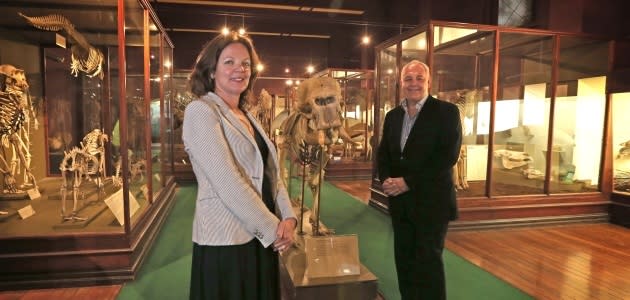WA public's vision to guide museum
People power will generate the creative vision for the new WA Museum, says the woman charged with overseeing the $428 million project.
British museum specialist Julie Finch said the facility would not be a temple of culture and science dictated by curators and "gatekeepers" but by the wishes of the WA public.
That input started this year with focus groups making suggestions in areas from the landscape gardening and eco-friendly design to the foyer and services areas, auditorium, cafes, shops, gallery spaces and toilets.
The ideas include a "see-through museum" of glass walls to give glimpses of the treasures within, an Aboriginal welcome ritual on entry, a rooftop bar- restaurant and exhibit-themed toilets.
Ms Finch, in Perth for meetings this week before taking up her post in January, said planners had taken these ideas into consideration. The project would only succeed if it was for the people and by the people, she said.
The outgoing Bristol Museum and Art Gallery director and former head of Britain's National Football Museum said she jumped at the opportunity to lead one of the biggest museum redevelopments in the world under chief executive Alec Coles.
Asked about her vision for the new WA Museum, Ms Finch talks about displays as theatre props to tell people’s stories and the building as a “soap opera” set where the public can meet, interact and experience something new every day.
Ms Finch is determined that the $428 million museum be much more than an architectural marvel of concrete, glass and steel.
Ms Finch oversaw the development of Bristol’s M Shed museum, which has had two million visitors since it opened in June 2011.
The project scope definition for the new WA Museum will be completed next month and a design team appointed about the end of 2014. With $155.8 million allocated this year in the budget forward estimates, construction is due to start in 2016 and the doors are expected to open in 2020.
Ms Finch was thankful that the design stage was still some way off. “It means that I can help shape it,” she says. “If that was a done deal, I wouldn’t have taken the job because I wouldn’t be able to use my skills as effectively.
“That is the funnel that all these ideas will go into from the public, from the museum team and from consultants. It will all be in the creative mix. Next year is going to be hugely interesting.”
The first physical step towards the new museum will be a $17.5 million revamp of its Welshpool storage and research centre next year.
The new Perth Cultural Centre complex will knit into the current heritage buildings and cover 23,000sqm over five levels, more than four times the size of the existing facility. About 8500sqm will be devoted to gallery space — more than the National Museum of Australia in Canberra (6600sqm) and the Australian Museum in Sydney (6000sqm).
The outline for the galleries — flexible, adaptive and multi-purpose — is now clear enough, Ms Finch says.
“There is now more of a sense of beginning to bring together the building and the visitor experience in a much more holistic way so that the building works for the public.”
The collection of 4.5 million objects provides one of the biggest sources of content in the English-speaking world, so the scope and details of the exhibits will come later.
“But we do know that the whale will go in somewhere,” she says of the most famous skeleton in the State.
Mr Coles and Ms Finch said the project team had taken all these ideas into account.
The Bristol redevelopment amounted to about $47 million but Ms Finch says she is excited rather than daunted by the big project facing her in Perth.
“I am a careful practitioner and I trust my judgment,” she says. “I’ll be working with a team, and with Alec, and am looking forward to the debate and will always ask the difficult questions.”
Ms Finch will be guided by a spirit of openness as the head of the creative team which includes museum exhibitions manager Trish McDonald and Bill Seager, the former redevelopment content manager at the Tasmanian Museum and Art Gallery.
“When you are challenged by different groups and organisations on what the museum should be, you have to be willing to discuss and debate,” she says.
A former teacher turned history scholar and then museum director, Ms Finch ran the UK’s National Football Museum in Manchester for two years and traces her interest in the emotional, educational and narrative power of collections back to her antique-dealer father.
“I felt very passionate about all the things he used to buy and store in our house, and then he would sell them to the Americans. And I had these outraged moments as an eight-year-old, saying ‘You mustn’t do that, you need to keep that, that’s our heritage’.”
A regular visitor to WA for 23 years to visit family, Ms Finch says the museum must be a gateway to an extraordinary place with many secrets the world should know more about, including its millennia-old Aboriginal rock art, Dutch shipwrecks and biodiversity.
It also must be truly distinctive and a destination to encourage tourists and repeat visits from locals.
“People do go to places because of museums and that is something that Alec and I would like to see. Tourism is really important to the economy but we need attractors. Of course, there are wonderful beaches here, and all sorts of things to do, but the museum is absolutely crucial to develop that sense of place.”
People can have a say in the new museum at: museum.wa.gov.au/new-museum/ your-museum-your-say.



